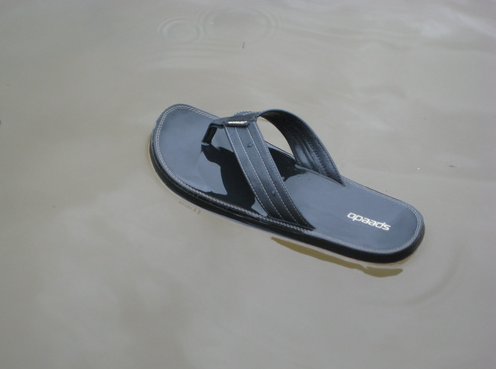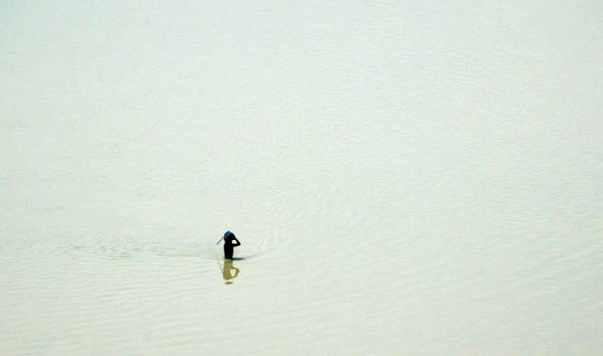This is going to be a brief post as I’m not through cleaning up the basement that was flooded this weekend. Of course, the damage was not even close to what people are experiencing in the Gulf Coast, while many other people will not have had to worry about water at all. The question for all of us, regardless of circumstances, is what is there to learn from being flooded? When I looked through the photographs in the papers I realized that one lesson was hidden in plain sight. Somewhat like this, perhaps:
You are looking at a car under water on a Chicago highway. Nice car, isn’t it? It’s also a nice photo: The dirty water is everywhere, making the car appear all the more self-contained and beautifully machined. The car is both there and not there, seen yet only partially visible, as if already being transmuted into a ghostly counterpart of itself. The streamlined design and smooth surface implies power and mystery as if it were to emerge like some god out of the primal waters, except that you know that everything is going in the other direction. This vehicle will be written off as a complete loss.
The hurricane and flood coverage has been all about loss. The loss of property, to get right down to it. Granted, there has been little loss of life and the deaths largely are unknown or kept private, but I doubt those are the only reasons that so much of the coverage features the destruction of property. The encounter with nature reveals any society’s preoccupations. A modern, capitalist society is one that is absorbed with the acquisition of material things. Nothing wrong with that, but it does shape our emotional response to what happens. Perhaps that is why I liked this photograph:
A single sandal floats, almost as if it had been made for floating. It is a small and inexpensive thing, yet it has the same sleek design and machined look of the car in the first photo. And this photo also is about being both present and absent. The sandal is there, ready for wear, just the thing for a wet day, and yet it is a study in subtraction. It’s mate is missing, and more to the point its owner is no longer there. Again, person and property have been separated. If the image is poignant it is because we realize that only the property remains. That sandal could last for centuries, but the naked foot that fits inside can only last a few years before being reabsorbed into the earth.
Which is why I’ll close with this photograph.
A villager is walking through floodwaters in Kumarkhad, India. The photograph reflects both the flood and a latent Orientalism, but let’s use that frame for the moment. The tone here is one of serenity–and that of the “perennial philosophy” of Eastern nonattachment. We see no property whatsoever, only a single human being half-immersed in oceanic stillness. This is not a study in loss but rather a depiction of eternal return: from nothing, through the small disruption of the waters that is human consciousness, to nothing.
I don’t think you will see many photographs like this in media coverage of the flooding in the US. People will be picking through their broken, sodden property and holding on to whatever they can. After all, what else can they do? This is no time to ask them for transcendence. Those who have not lost so much, however, might want to think about why we hold on so tightly to what are just things. Why we hold on to them because we are trying to hold on to something else that is sure to slip away.
A hard lesson, perhaps, but no reason to be mournful. Rilke knew as much:
And though you fade from earthly sight,
declare to the silent earth: I flow.
To the rushing water say: I am.
The Sonnets to Orpheus, by Rainer Maria Rilke; translation by Robert Hunter.
Photographs by Abel Uribe/Chicago Tribune, unknown/Chicago Tribune, and Diptendu Dutta/AFP.



the response of Chicagoans to flooding has been interesting in light of this post. for the most part, if the area flooded is a park or empty space, no one minds, and there’s a sense of relief that it wasn’t something “more important,” which, presumably, means stuff. I watched a flooded underpass from my window at work and gauged people’s common sense based on how determinedly they drove into the water and how expensive the cars were which they inevitably stalled and crawled out of.
the most disturbing view was near Foster and Pulaski, where a statue in Gompers Park loomed out of the water like something from Planet of the Apes. police were sandbagging; entire sections of the two nearby cemeteries were underwater.
this post reminded me of chris jordan’s *in katrina’s wake: portraits of loss*–which are more sublime than muddy images of absence after the storm waters subsided–as well as images of (aesbestos-laden) dust post-9/11 on jeans in NYC…it is challenging to visually articulate disaster in a way that enables critique.